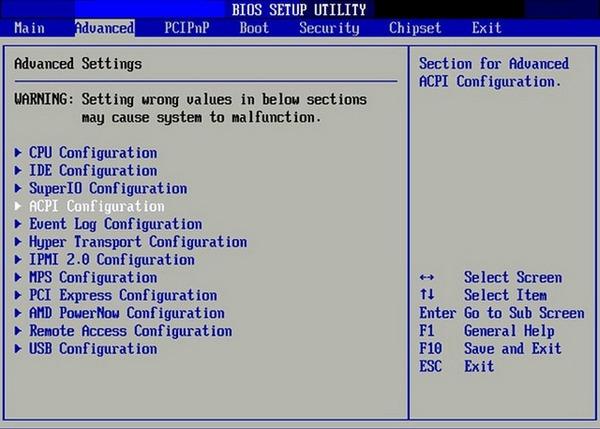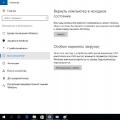Bios disable usb ports. How to enable USB support in BIOS on your PC
If USB ports are not working on your PC, and Windows settings and driver updates do not help, the controller may have been disabled in BIOS. In this case, you will need to go to the configuration menu and turn everything back on.
There are many different versions BIOS with their interfaces and subtleties of work. Also, a more modern complex can work on your computer - UEFI, which supports a full-fledged graphical interface. This article discusses distributions that are most often installed on motherboards.
Entering BIOS settings
To start changing the configuration, you need to get into the corresponding menu. It can be opened when the personal computer is turned on - before Windows starts loading from the hard drive.
Turn on the PC. In case it's already running: reboot. Wait for the speaker to beep: a short single beep indicates that all the internal components necessary for the operation of the computer have been detected.
Now you need to press hotkey to call the configuration. This must be done before changing the screen. If you didn’t have time, and Windows started loading, reboot. The keys depend on the installed motherboard model and BIOS firmware version. You can find it in the user manual that came with the motherboard, on the official website of the manufacturer or view on your PC screen when loading it:

If you don't know the board model, it's okay. Just try pressing the following keys: Tab , Delete , Esc , F1 , F2 , F8 , F10 , F11 , F12 . One of them will surely fit..
It is not necessary to try only 1 option at a time. You can quickly click all the buttons from the list without any problems. One of them will come up and start the BIOS settings, and the rest will be ignored.
Entering the BIOS/UEFI settings of the latest PCs
Many modern computers boot up so quickly that it is impossible to get into the keystroke method when turning on. This is also true for laptops. Therefore, the latest versions of Windows have acquired a new launch feature. Let's use Windows 8.1 as an example.


Your PC or laptop will restart in setup mode. After restarting the PC, you will also be able to select option to run from a USB drive or DVD disc.
Menu navigation
Almost all BIOS versions lack a graphical interface. This means that you will only have to work using the keyboard, as, for example, in the Windows console. Navigation is carried out using the up-down and right-left arrows. To open any section, use the Enter key to go back - "Escape". A small memo on the keys used is always shown on the screen.

Firmware complex UEFI installed on the most expensive and powerful motherboards. It supports more drivers and able to work with a mouse. Its interface will be familiar to users of Windows and other modern operating systems.

Each version has its own interface and set of options. Even the names of the same parameters may differ. The following article describes several popular BIOS releases.
AMI BIOS
A very common option that can be found on many modern computers. The main menu is divided into 2 parts: a list of categories and various actions like exit or save. You will work on the left side.

You need to go to the section called " Integrated Peripherals". There is no Russian version of the interface, so all commands are in English only. Use the Down arrow to highlight this item and press Enter .
Here you need to enable Enabled) 4 options:
- USB EHCI controller- main controller. If the motherboard has version 3.0 ports, this item will be divided into 2 parts: "Controller" and "Controller 2.0";
- USB Keyboard Support– support for keyboards;
- USB Mouse Support– mouse support;
- – work with external data storages: flash drives, disk drives, disks of smartphones and digital cameras.

In some older versions, there are only 2 items " USB controller" And " Legacy USB storage support».
When you're done with the settings, press the F10 key to save your changes and restart your computer.
Phoenix AwardBIOS
Another popular version that can often be found on modern laptops. It does not have a main page, like AMI, but is equipped with convenient thematic tabs at the top. You can move between sections using the "left" - "right" arrows, and between items - using the "up" and "down" arrows.

Go to the section " Advanced» using the Right arrow. Find the category " USB configuration". All paragraphs of this section must be translated into the provision " Enabled". In some versions, the category " USB configuration” may be in the tab “ Peripherals” and not in “Advanced”.
To exit the menu, press F10 and confirm exit.

AMI BIOS for Asus
AMI version used on Asus laptops. Outwardly, it is very similar to Phoenix - a similar bookmarks bar. Settings USB are in the section Advanced". Go there, enable all options and exit with the F10 button.
UEFI
Contrary to popular belief, UEFI is not part of the BIOS. It can rather be called a more advanced, but less popular competitor. There are a large number of different versions, each with its own interfaces. However, here the control is similar to the familiar Windows, so you can easily find the options you need.

Windows Settings
If at the BIOS level all ports and controllers are enabled, but the USB ports still do not work, the problem may be in the settings of your Windows system.
First, just try disconnect and reconnect the device. This will cause the drivers to be validated. If something is wrong with them, Windows will try to reinstall them.
If nothing happens when reconnecting, try turn on the controller in the Windows registry. To do this, do the following:

Video: how to set up any BIOS to boot from a USB flash drive
It happens when USB ports stop working on computer. In this article, we will look at the common causes that lead to such a problem, and how to solve it. The very first thing you can do is restart your computer, as frequent problems with USB ports are due to an error in the driver. If this method does not help, go ahead.
Perhaps the settings in the BIOS of the motherboard have gone astray. If the corresponding usb controller is disabled for some reason, it must be enabled. When starting the computer, press the Del or F2 key to get into the BIOS. Next, in the Integrated Peripherals or Advanced section, we will find a similar item on the USB Controller and look at what position it is in (Enabled - enabled, Disabled - disabled). So, if you have the Disabled mode set, change it to the opposite. To save the changes, press the F10 key and agree by pressing YES. After the reboot, the ports should work, if it doesn’t help then follow the steps below.
Reasons why USB ports on a PC do not work:
- Faulty any USB device: I recommend turning on the computer, after turning off everything (mouse, keyboard, printer, webcam, etc. devices). Leave only one working flash drive. If the flash drive works when you start the computer, then the peripheral devices are to blame. You can determine which one is faulty by connecting it to a computer in turn.
- ports may not work due to faulty program code. We go to "Task Manager".


We carefully look in the paragraph "USB serial bus controllers", if there is a device with an exclamation mark, then this indicates that it is not working properly. Double-click to open it, and in the window you can read information about the malfunction.
- Alternatively, you can delete all controllers responsible for USB, and then reboot the system. After starting, Windows will automatically reinstall them. After that, it is likely that the USB ports will work.
- If the problem with the ports is due to a failure in the program code, then you can try to restore the operating system, that is, roll it back to the last checkpoint. We go to the "Start" menu - "Control Panel". Here we find the section "Recovery".

Next, click the "Start System Restore" button. A recovery window will open and you can use the prompts to roll back the system.

- Also, a similar problem may occur due to the lack of a driver for the motherboard chipset. In this case, you need to drive this data on the manufacturer's website. After downloading and installing the driver, you should restart your computer.

- To make sure the problem is in the system or hardware, you can boot from any Live CD. If, after booting from such a disk / flash drive, the ports work, then the problem is definitely in the operating system and there is only one way out - to reinstall Windows. If USB does not work in the virtual system, then the problems are in the hardware. In this case, we do what is written below.
There was a case with a friend when the ports stopped working. Replacing the 3 volt battery on the motherboard solved the problem.

- Alternatively, you can update the BIOS. This solution helps many users. To update the BIOS, go to the official website of your motherboard manufacturer and in the "Download" section, find the latest BIOS version. You will also find detailed instructions for updating there.

- If you have frequent problems with USB ports, I recommend installing a PCI-USB controller. Nice thing to be independent of your built-in ports.

- The last option is to send your PC in for repair, where professionals will probably make an accurate diagnosis.
That's all, friends! Thank you for your attention!
This article focuses on the question of how to enable USB support in the BIOS. As it turns out, not all users know that the functions of the Universal Serial Bus (in Russian interpretation - "Universal Serial Bus") can be enabled and configured through BIOS Setup. We will not focus on the circumstances due to which you may need this operation - they may be different. For example, you find that the USB devices on your computer are slower than they should be, and you want to check if your computer's BIOS supports the latest version of the standard for this bus.
To get started, enter BIOS Setup when booting your computer and laptop. How to do this, was devoted to a separate article on our website. However, it is worth noting that the BIOS section with USB functions is not always evident to the user. In addition, for different BIOS manufacturers in its different versions, bus management functions can be placed in different sections. These can be Advanced, Integrated Peripherals, Onboard Devices, etc.
It may, of course, happen that there is simply no section with configuring USB functions in the BIOS of your laptop or desktop computer. This situation can most often occur in laptops, in which the number of options available to the user is generally not very large. In the BIOS of my HP netbook, for example, I did not find such an option, no matter how I searched. Well, then, it's not fate ...
Setting USB options in BIOS
The number and set of USB functions that you can adjust in the BIOS can also vary greatly depending on the version. Often in Setup you can set support for a USB mouse and keyboard, attached external drives. You can also disable/enable the ability to connect USB devices altogether or enable support for a specific version, such as USB 2.0.
List of the most common USB options (different BIOS versions may have different names):
- USB Function - enable/disable the Universal Serial Bus controller
- USB 2.0 Controller Mode - switch the USB 2.0 controller to 1.1 mode and vice versa
- Assign IRQ For USB - assign IRQ to USB devices
- USB Speed - setting the speed of the USB bus
- - USB keyboard and mouse support
- USB Storage Support - support for external drives on this bus
- Emulation Type - setting emulation modes for USB drives
Once you've set the option you want, don't forget to save it by selecting the BIOS Setup "Exit and Save Changes" option to restart your computer.
When setting USB options in the BIOS, however, you should be aware that setting them incorrectly can lead to the inoperability of any devices permanently connected to the universal serial bus, such as a keyboard or mouse.
Conclusion
In this article, you learned how to enable USB support, as well as set USB options in the BIOS of a computer or laptop. As a rule, this operation is quite simple and will not take you much time.
Why don't usb ports work? Reasons and solution
Usb interfaces are used in the PC robot so often that we cannot even imagine a computer or laptop without them. Various peripheral devices are connected to the USB interface: printers, web cameras, flakes and many others. But what to do if the usb ports are out of order. Let's look at the main problems with usb operation and try to fix them.
USB interfaces disabled in BIOS
This problem is very common, because a sudden turn off of the light or a dead battery can throw off the BIOS settings, thereby disabling the USB interfaces.
To enable them, let's enter the BIOS, for this you need to quickly press the Del or F2 button after starting the computer.

Depending on the version and manufacturer of the software, enabling USB functions can be in different BIOS items.
- Main BIOS options:
- Enable/Disable - Disabled/Enabled
- Make all USB ports available - Both
- Make available ports that are placed directly on the motherboard -Primary
- Number of used USB ports - 2USB Ports, 6USB Ports
- Using USB 2.0 - USB 2.0 Controller.
- Changing the operating frequency of the USB bus - USB Speed.
Enabling Usb in AMI BIOS

Enabling Usb in Award BIOS

USB port driver removed from system
Errors of this kind occur after a virus attack on a computer or a critical Windows error field. To restore the functionality of the USB controller, it is worth installing or, in case of incorrect operation, updating the USB controller drivers. Follow these steps to update the USB driver:
1.Open Device Manager from the Hardware tab in System Properties.

2. Find the USB controller item and right-click on it and select "Update driver".

3. In the hardware wizard that starts, select the "Automatic installation" item to search for a suitable driver.

4. The wizard will find the driver we need and install it.
5. If the wizard could not find a suitable driver, we will need to download it from the Internet and install it from the specified location. To do this, when choosing the option to install the driver, you need to select the item "Install from a list or specified location". In the next window, we will be prompted to search for drivers in the specified locations. Check the box next to "Include the following search location" and click browse.

In the drop-down menu, specify the package with the downloaded drivers. The wizard will check the folder for a suitable driver and select the correct one. After that, for the correct installation, it is worth restarting the computer.
The USB controller burned out.
There are times when, due to high voltage, the USB controller overheats and fails. Only a service center can help you solve this problem, since it is not possible to fix it at the software level.
 Step-by-step PC troubleshooting
Step-by-step PC troubleshooting How to create your first mobile app
How to create your first mobile app